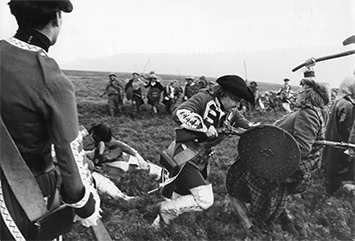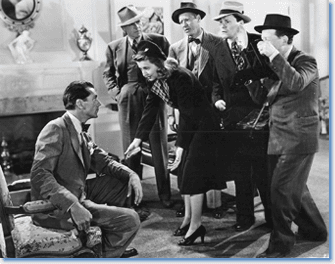In his recent Perspectives article about making the historical documentary The Great Depression for public television, historian James Green describes his experience in collaborating with filmmakers. Green explains that working on The Great Depression made him acutely aware of the different objectives of history with its empirical tradition and its emphasis on instructive interpretation and [documentary] filmmaking with its artistic tradition and emphasis on dramatic presentation (Perspectives, October 1994, p. 6). In Green’s case, the collaborative effort involved a film about the 1930s—an era for which newsreel footage, still photography, and participants and witnesses can be used to augment the documentary record. Green describes how those source advantages, as seen from the perspective of a historian, can restrict the visual and dramatic options of a filmmaker. By contrast, those seeking to portray an earlier era on film, an era for which the range of visual and documentary sources is inevitably more limited, might be both forced and allowed to find creative, yet historically plausible solutions to the problems of presenting an incompletely documented story.
As both history and drama, Mary Silliman’s War works, satisfying many of the potentially conflicting goals of filmmakers and historians. From the outset, the visual and dramatic quality of the film is impressive. Shot on location in Nova Scotia, the film offers a convincing portrayal of late 18th-century Connecticut. Throughout the film, the fine cast and the well-crafted script, filled with compelling scenes and dramatic tensions, keep the story moving apace.
The film offers a convincing social portrait of a community—Fairfield, Connecticut—during the Revolutionary War, from the vantage point of one woman, Mary Silliman, and her family. The story weaves together an array of thematic threads: community relationships and tensions (the Revolution as a civil war), gender role expectations and realities, religious culture and moral principles, and family as both a private and a public institution. The filmmakers set an ambitious goal for themselves in their attempt to deal with all of these themes, and in some instances the interpretive treatment is inevitably more suggestive than complete. Yet the film manages to show how various components of 18th-century society overlapped, reinforced, and sometimes contradicted each other. And the film works as social history because the focus stays squarely on Mary Silliman’s experience and her perspective on the events that take place, without presenting her either as a unique or a typical colonial New England woman. Thus it suggests rather than forces generalizations about women’s experience during the Revolution.
Mary Silliman’s War also provides a remarkably persuasive—and long overdue—representation of a civilian experience of the Revolutionary War. It focuses on one rural community of colonial Americans—in a world that was indeed immediate and local—rather than on the distant military events of the Continental Army or the political concerns of the Continental Congress. That local focus helps to make the variety of political, economic, and social decisions that confronted individual Americans like Mary Silliman and her neighbors more palpable, and illustrates the extent to which the revolutionary conflict affected the lives of ordinary civilians, their families, and their communities.
The story is well grounded in the fine scholarly biography of Mary Fish Silliman, The Way of Duty: A Woman and Her Family in Revolutionary America (W.W. Norton, 1984), by Joy Day Buel and Richard Buel, Jr. The biography is based on Mary’s extensive family correspondence, her journal, and her reminiscences, written in 1800. Both the biography and the film benefit from her fluent and introspective voice. Yet the film dramatizes a period—May 1779 to April 1880—for which the documentary record is particularly fragmentary. The producers, working with Richard Buel and a team of historical consultants, took clues from the entire correspondence and from Silliman’s journal to put together a likely reconstruction of her actions and reactions to the events of that period.
As the study manual that accompanies the videotape of Mary Silliman’s War explains, several sorts of liberties had to be taken with both the book and the historical record to make the story the film tells both self- explanatory and dramatically intelligible to a 20th-century audience. In some instances, the production team made significant interpretive choices. The extant letters do not provide either a daily record or a social context of friends and neighbors for the Sillimans. So the producers invented a historically plausible social context for the Sillimans. The characters of some historical figures who participated in the events have been augmented in the story by documentary evidence about other individuals from that era and society. Other characters were invented for the story, but again their actions and reactions are based on the biographies of contemporary individuals.
The film opens with the first of a number of contrasting points of view. A woman’s voice-over explains that, while the American Revolution was being fought in distant battles, our war was amongst ourselves. She describes the immediate context of the war in Fairfield: those who had been neighbors (and who continued to have much in common) had become politically divided between Loyalists and Patriots. That woman’s view—family oriented, community oriented—contrasts with her husband’s extralocal, political perspective as the state’s attorney prosecuting Loyalists as traitors. Setting local community ties against larger political allegiances, Mary Silliman expresses her faith that her husband Selleck will be the voice of moderation and mercy in the trials. But in her account of the subsequent trial and its outcome, the death sentence for treason for two young Fairfield Loyalists, she finds that she cannot justify s uch a harsh judgment—the result of the application of revolutionary political and military principles—especially when she considers the effects it will have on the families of the young men.
The tension between political and community perspectives is reflected in the tension within the Silliman household after the trial as Mary questions Selleck about his reaction to a process that led to a sentence not of imprisonment but execution for the two young men. To what he perceives as her challenge, he responds, I will not tolerate this rebellion in my own home. By contrasting Mary Silliman’s immediate and compassionate view of her world with that of her husband and the larger community, the film suggests some of the complexities of women’s role within the family and society. On the one hand, both women and men generally accepted women’s subordinate position. But on the other hand, women such as Mary Silliman clearly and ably thought for themselves, and in so doing sometimes found themselves in an awkward disagreement with both their husbands and their community.
The night of the trial, angered relatives of the young men kidnap Silliman, take him to occupied New York, and sentence him to hang when the two Fairfield Loyalists are executed. As Mary Silliman, pregnant and solely in charge of her household, tries to cope with the horror of this turn of events, she also begins to struggle with her religious faith, and with a pastor who counsels her that God’s will be done—even if God’s will might lead to the death of her husband or her unborn child. While she continues to seek her pastor’s guidance, she begins to question the blind faith that he advises. By contrast, Selleck’s religious conviction allows for action in addition to faith. In a letter written from prison in New York City, he advises Mary on the means of effecting his release, writing that God’s will be done, but the use of means is also our duty.
In these opening dramatic sequences, the filmmakers set up a series of contrasts and conflicts that encourage the consideration of a number of larger themes in 18th-century New England society. Through the rest of the film, the story explores the complexity of some of these issues.
For example, in the aftermath of the trial and kidnapping, Mary Silliman’s political perspective evolves. As the war directly affects her immediate situation, her necessary responses lead her to take a more active and assertive role both in running the homestead in her husband’s absence and in bringing about his release. In so doing, she begins to take a different view of the revolutionary concerns and principles that she previously had encountered only secondhand, and gradually she comes to support those principles even at the expense of some of the community-oriented values that she once held higher. While she never loses her compassion, she understands that in war the answers aren’t always easy. Thus, she decides to con done a violent act—the kidnapping of a high-ranking Tory to be exchanged for Selleck Silliman—when all other means of effecting her husband’s release have failed. While she justifies that act from a woman’s vantage point—she needs a husband and her children need a father—nonetheless she has chosen an action based on military strategy.
Similarly, her preferred acceptance of gender-role expectations is tested when she finds that her necessary actions challenge familiar assumptions about appropriate and inappropriate behavior for women. When she brings a petition for her husband’s release to the governor of Connecticut, she defers to the council in her defense of the petition, acknowledging that it is not the province of my sex to consider such matters. In a patronizing manner, one member suggests that the petition is completely clear on all the points that she tries to raise. At the end of the interview, she tentatively but resolutely asks the council to allow a poor woman one observation: that the policy of enforcing loyalty with a hangman’s noose … will begin a round of bloodletting. In spite of her deferential demeanor, and the councilmembers’ assumption that she could have nothing of substance to contribute to their deliberation, her observation so disconcerts the governor that he decides to take the matter to the people of Connecticut.
The film also suggests some of the complexity of race and class relations in revolutionary New England. The Silliman household includes Peter, an African American servant who manages the farm; Amelia, a young woman working in the house who occasionally attempts to subvert her mistress’s authority; and Adam Sayres, a hired farmhand whom Mary fails to see as a Loyalist and traitor in disguise. In one sequence, Peter offers to join the Continental Army (by which action he will gain his freedom). While Mary Silliman describes Peter as a most loyal friend, she considers his request only in terms of her need for his labor and her intention to defer to her husband’s decision-making prerogative; she does not consider his explicit wish to serve and his implicit desire for freedom. The film does not, and cannot, resolve larger issues of race (and of slavery and freedom) and of class relations. But it does present these issues as part of the configuration of community relations in late 18th-century New England.
The filmmakers have produced a compelling family story, centered in a credible 18th-century community, and set in the larger context of the American Revolution, using enough popular reference points to make it familiar to a broad audience. The producers made a number of interpretive decisions to ensure the dramatic flow and effect of the story. They attributed thoughts and actions to Mary Silliman that at best were plausible, and they set certain secondary characters (either composite or fictional) in stark contrast to Mary Silliman. Yet the film doesn’t present those dramatic tensions at the expense of its portrayal of day-to-day routines; it also captures much of the dailiness of rural life in 18th-century New England that continued in spite of the war.
Intended for senior high, college, and adult audiences, the film offers an intriguing and accessible text for discussion. The story presents some of the complexity of society in revolutionary New England in its juxtaposition of events, experiences, and perspectives. The study manual details five main themes that the film addresses and offers a series of questions that address those larger historical issues. In its suggestive treatment of some of the thematic threads that run through the story, the film undoubtedly will raise as many questions as it answers. But that often is the sign of a good and a provocative text.
A discussion of the collaborative team’s solutions to the problem of an incomplete story can contribute to the educational value of the film. As historians, we try to teach students to appreciate the difficulties of re- creating history from compelling but often insufficient documentary sources. As scholarly writers we generally stay close to the empirical evidence in our re-creation of historical events. Having done so we then offer a larger historical analysis and interpretation of those events. In some ways, this film works in reverse. In a historically sound way, the dramatization of Mary Silliman’s story fills in the gaps between the documented events. But while the story incorporates various themes that raise questions about the configuration of revolutionary New England society, it doesn’t seek to resolve issues of community relations (including race and class), gender and family relations, or religious beliefs. Nonetheless, the film demonstrates that history, carefully reconstructed, can be both dramatically moving and instructional.
Sarah F. McMahon is associate professor of history and past director of women's studies at Bowdoin College. She teaches the social history of colonial and early national United States with an emphasis on women's, family, and community history. She has been a consultant for a number of film and public history projects. Mary Silliman's War was produced by Steven Schecter and Heritage Films in 1993. The project received assistance from the National Endowment for the Humanities. Mary Silliman's War may be purchased on videotape; a study guide is also available. For details, write Heritage Films, 358 W. Foothill Blvd., Ste. 160, Claremont, CA 91711, or call (800) 400-3302.


